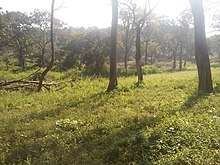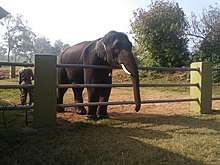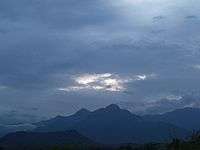Mudumalai National Park
The Mudumalai National Park and Wildlife Sanctuary also a declared tiger reserve, lies on the northwestern side of the Nilgiri Hills (Blue Mountains), in Nilgiri District, about 150 kilometres (93 mi) north-west of Coimbatore city in Tamil Nadu, India. It shares its boundaries with the states of Karnataka and Kerala. The sanctuary is divided into five ranges – Masinagudi, Thepakadu, Mudumalai, Kargudi and Nellakota.
Mudumalai National Park Mudumalai Tiger Reserve | |
|---|---|
National Park | |
.jpg) Entrance to Mudumalai tiger reserve | |
 Mudumalai National Park Location in Tamil Nadu, India | |
| Coordinates: 11°35′N 76°33′E | |
| Country | India |
| State | Tamil Nadu |
| Region | Kongu Nadu |
| District | Nilgiri |
| Established | 1940 |
| Area | |
| • Total | 321 km2 (124 sq mi) |
| Elevation | 1,266 m (4,154 ft) |
| Languages | |
| • Official | Tamil |
| Time zone | UTC+5:30 (IST) |
| Nearest city | Gudalur 7 km (4.3 mi) |
| IUCN category | II |
| Core of the Nilgiri Biosphere Reserve | Visitors Centre at Theppakadu |
| Governing body | Tamil Nadu Forest Dept |
| Visitation 2008 | 163,610[1] |
| Entry fee | Rs.15 per adult (No private vehicles allowed in the sanctuary) |
| Climate | Aw (Köppen) |
| Precipitation | 2,000 millimetres (79 in) |
| Avg. summer temperature | 33 °C (91 °F) |
| Avg. winter temperature | 14 °C (57 °F) |
| Website | www.forests.tn.nic.in |
The protected area is home to several endangered and vulnerable species including Indian elephant, Bengal tiger, gaur and Indian leopard. There are at least 266 species of birds in the sanctuary, including critically endangered Indian white-rumped vulture and long-billed vulture.[2]
The Western Ghats Nilgiri Sub-Cluster of 6,000 square kilometres (2,300 sq mi), including all of Mudumalai National Park, is under consideration by the UNESCO World Heritage Committee for selection as a World Heritage Site.[3]

Mudumalai Tiger Reserve
There are 48 tigers in the Nilgiri Reserve across which tigers are free to roam.
History
In April 2007, the Tamil Nadu state government declared Mudumalai to be a tiger reserve, under section 38V of the Wildlife Protection Act of 1972, in an effort to conserve the country's dwindling tiger populations. Subsequently, about 350 families living in the core area were evicted from the park and given INR 10 Lacs compensation. Those in the 5 km buffer area around the park fear they, too, will be evicted; nobody will be dislodged from the buffer zone. In fact, some people in this zone will become trackers and guides to enhance their income through eco-tourism.[4]
Continuance of 'Project Tiger' in Mudumalai Tiger Reserve for FY 2010/11, at the cost of INR 4 Crores was approved by the National Tiger Conservation Authority on 16 September 2010.[5]
Flora

There are three main types of forest in the sanctuary: tropical moist deciduous occur in the western Benne Block, where rainfall is higher than in the other blocks. Tropical dry deciduous forest occurs in the middle and southern tropical dry thorn forests are in the east.
In addition there are patches of tropical semi-evergreen forest in the southwest and western part of Mudumalai. The annual rainfall there exceeds 2,000 mm (79 in). Tree species in this habitat include Casseria ovoides, Litsea mysorensis, Cinnamomum malabatrum and Olea dioca. Climbers including sneeze wort (Dregea volubilis), Gnetum ula and Entada scandens are also found in these semi-evergreen forests.
Moist bamboo brakes are found amidst dry deciduous, moist deciduous and semi-evergreen forests and along the fringes of riparian forests and swamps. There are two species of bamboo found in Mudumalai, the giant clumping bamboos: Bambusa (arundinacea) and Dendrocalamus strictus. Elephants and gaur eat both species of bamboo. In all types of forest, a green strip of riparian forest is seen along the shore of dry seasonal and perennial streams. This type of forest remains green in all seasons. The plant species found here includes: Mangifera indica, Pongamia glabra, Terminalia arjuna, Syzygium cumini, Indian rosewood Dalbergia latifolia and the bamboos. Larger mammals such as elephant, gaur, sambar and tiger use riparian forest patches for feeding and resting.
This sanctuary is home to several species of wild relatives of cultivated plants including wild rice, wild ginger, turmeric, cinnamon, solanum, guava, mango and pepper that act as a reserve gene pool for the cultivated plants.[6] In places mixed vegetation types are present. The deciduous trees shed their green leaves during the summer, and adopt a floral garb while the arrival of the monsoons hails fruits and tender greens.[7]
Fauna

There is a high diversity of animal life in the sanctuary with about 50 species of fishes, 21 species of amphibians, 34 species of reptiles, 227 species of birds and 55 species of mammals. Mammal diversity is higher in the dry deciduous and dry thorn forests than in the other habitats. Thirteen percent of all mammal species in India are present in Mudumalai wildlife sanctuary.
| Mammal species[6] | found in India | in Mudumalai | and their percentage in MWS |
|---|---|---|---|
| Order | # species in India | # species in MWS | % in MWS |
| Primates | 15 | 3 | 20.00 |
| Even-toed ungulates (deer, gaur, pig) | 34 | 7 | 20.50 |
| Proboscidea (elephant) | 1 | 1 | 100 |
| Carnivora (tiger, leopard, sloth bear) | 58 | 19 | 32.70 |
| Pholidota (ant eater) | 1 | 1 | 100 |
| Lagomorpha (black-napped hare) | 11 | 1 | 9.09 |
| Insectivora (shrew) | 3 | 2 | 66.66 |
| Rodentia (rats, squirrel) | 102 | 14 | 13.73 |
| Chiroptera (bats) | 113 | 7 | 6.19 |
Of 15 cat species in India, four live in Mudumalai: Bengal tiger, Indian leopard, jungle cat and leopard cat. There are 44 to 80 tigers in the Mudumalai forest. The single largest tiger population in India (Mudumalai – Nagarhole – Wynad) includes the Mudumalai tigers. These tigers are a breeding source for populating the northern and eastern parts of the Western Ghats. This population exists at high density due to the high density of prey species thriving in its deciduous forests.[8]
The Indian leopard (P. pardus fusca) (NT) is most often seen in the Kargudi area. Other carnivores include the dhole (Cuon alpinus) (V), the striped hyena (Hyaena hyaena) (NT), the golden jackal (Canis aureus) and the sloth bear (Melursus ursinus) (V). The population of Indian elephants, Elephas maximus indicus (E), totals several hundred animals. Three primates found here include the gray langur (Semnopithecus priam) and the bonnet macaque (Macaca radiata). Important prey animals for large carnivores here are the ungulates including the gaur (Bos gaurus) (V), the sambar deer (Cervus unicolor) (VU), the chital deer (Axis axis), Indian muntjac (Muntiacus muntjak), the Indian spotted chevrotain, Moschiola indica, and the wild boar (Sus scrofa), all of whom are common here. Rodents include the Indian giant squirrel (Ratufa indica maxima) and the red giant flying squirrel (Petaurista petaurista).
Some reptiles found here are the python, flying lizard, spectacled cobra, krait and Asian pit vipers.[9] The monitor lizard is the most regularly observed species.
Avifauna
Eight percent of bird species in India occur in the Mudumalai Wildlife Sanctuary. Among the 227 bird species found in Mudumalai, 110 species are insectivores, 62 are carnivores, 23 species are fishivores, 12 species are omnivores and 20 species are granivores. These include the unique near threatened black-and-orange flycatcher. Regional endemics include Malabar trogon and Malabar grey hornbill. Some rare birds of prey like the rufous-bellied eagle can occasionally be seen in this sanctuary. Other predatory birds include crested serpent eagle, changeable hawk eagle, black eagle, Oriental honey-buzzard, Jerdon's baza, Bonelli's eagle, crested goshawk, besra, mottled wood owl and brown hawk owl, and several minivets.
There are also hornbill, golden oriole, chloropsis, paradise flycatcher, golden-backed woodpecker Malabar great black woodpecker, blue-winged parakeet, fairy bluebird, jungle fowl racket-tailed drongo, peafowl, red spurfowl, grey francolin, painted spurfowl, painted bush quail, white-bellied woodpecker, lesser yellownape, golden woodpecker, streak-throated woodpecker, chestnut-headed bee-eater, emerald dove, green imperial pigeon, grey-fronted green pigeon, grey-bellied cuckoo, Indian cuckoo, alpine swift, black-hooded oriole, greater racket-tailed drongo, black-headed cuckooshrike, grey-headed bulbul, forest wagtail, crimson-backed sunbird and Loten's sunbird. It also holds the isolated southern population of the striped tit-babbler.[9][10]
Threats
Tourism, especially in the Segur/Masinagudi area, is claimed by some to pose a threat to the region, but this is strongly repudiated by persons who live and work in the area. The extensive growth of Invasive species, such as lantana, that hinder the natural regeneration process of the forests has occurred as a result of excessive cattle grazing.[7] Construction activities of the proposed India-based Neutrino Observatory at Singara, Masinagudi, are likely to have significant impacts on the local wildlife. The 5-year work plan, high volume of debris and waste disposal, blasting activities, extensive vehicular activity and large number of outside workers and their support infrastructure all threaten to disrupt the wildlife corridor on the Sigeur plateau, including Mudumalai Sanctuary, connecting the Western Ghats and Eastern Ghats.[11][12][13]
Documentary
See also
References
- B. (1986). Mudumalai Sanctuary. India's wildlife and wildlife reserves. Sterling Publishers, New Delhi.
- Sharma, B.D., Shetty, B.V., Virekananthan, K. and Rathakrishnan, N.C. (1978). Flora of Mudumalai Wildlife Sanctuary, Tamil Nadu. Journal of the Bombay Natural History Society 75: 13–42.
- Plan for Mudumalai Wildlife Sanctuary and National Park (2007–08 to 2016–17)[6]
Notes
- D Radhakrishnan. 'Mudumalai Tiger Reserve to sport new features', The Hindu, 02/11/09
- "Mudumalai Wildlife Sanctuary". Conservation database. Bangalore: Ashoka Trust for Research in Ecology and the Environment Eco-Informatics Centre. Archived from the original on 24 December 2009. Retrieved 9 November 2009.
- UNESCO, World Heritage sites, Tentative lists, Western Ghats sub cluster, Ooty. retrieved 20 April 2007 World Heritage sites, Tentative lists
- Murari, S. (31 December 2008). "Thousands Protest Against Indian Tiger Reserve". Planet Ark. Reuters. Archived from the original on 16 July 2011. Retrieved 30 October 2009.
- Rajesh Gopal, APCCF (PT) and Member Secretary (NTCA) (31 August 2010), "Centrally Sponsored Plan Scheme 'Project Tiger' Administrative Approval for funds release to Mudumalai Tiger Reserve, Tamil Nadu during 2010–11." (PDF), No. 4-1(32)/2010-PT, New Delhi: National Tiger Conservation Authority, archived from the original (PDF) on 6 January 2011, retrieved 2 February 2011
- Dogra, IFS, Rakesh Kumar, Wildlife Warden, Plan for Mudumalai Wildlife Sanctuary and National Park (2007–08 to 2016–17) Udhagamandalam, Tamil Nadu Forest Department, Mount Stuart Hill, Udhagamandalam-643 001, Tamil Nadu, India
- "Mudumalai Wildlife Sanctuary". Sanctuary Asia. 2009. Retrieved 5 November 2009.
- Qamar Qureshi; K. Sankar; Rajesh Gopal; Y.V. Jhala (2008). "Western Ghats Landscape Complex/Tamil Nadu" (PDF). STATUS OF TIGERS, CO-PREDATORS AND PREY IN INDIA. National Tiger Conservation Authority Ministry of Environment & Forests and Wildlife Institute of India. pp. 72–94. Archived from the original (PDF) on 2 June 2013.
- "MUDUMALAI WILDLIFE SANCTUARY & NATIONAL PARK". Wild Biodiversity. TamilNadu forest Department. Archived from the original on 9 April 2009. Retrieved 30 October 2009.
- Praveen J., Job K. Joseph & Nick Lethaby (2004) Sighting of Yellow-breasted Babbler Macronous gularis in South India. Newsletter for Ornithologists 1(3):43 PDF Archived 17 September 2006 at the Wayback Machine
- "Tiger vs Science". The Hindu. 2008. Archived from the original on 11 December 2008. Retrieved 29 June 2008.
- Azeez, PA; S Bhupathy & P Balasubramanian (after 30 May 2008). "D. Division of Environmental Impact Assessment" (PDF). Rapid Environmental Impact Assessmentof the India-Based Neutrino ObservatoryProject, Singara, Nilgiris, Tamil Nadu. Annual Report 2007 – 2008. Sálim Ali Centre for Ornithology and Natural History. Ministry of Environment and Forests. pp. 46, 47. Check date values in:
|date=(help) - The New Internationalist (2008). "Tiger vs Neutrinos". Archived from the original on 14 August 2008. Retrieved 4 August 2008.
External links
| Wikimedia Commons has media related to Mudumalai National Park. |
.jpg)
- UNEP World Conservation Monitoring Centre Fact Sheet, 1988
- Elephants in Mudumalai NP by an expat living in India (pictures + French text)
- Mudumalai wildlife and landscapes
- Mudumalai Photos 15th Aug 2006 – Courtesy Sasikumar & Ananthi
- Mudumalai Wildlife Bird Photographs
- Mudumalai Accommodation
- NBR Alliance
- Mudumalai Accommodation
www.mudumalainationalpark.com

.jpg)



